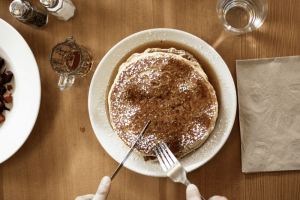
Smart Tips for Choosing a Restaurant Concept
At a glance, choosing a restaurant concept can seem very arbitrary, but in actuality, it’s one of the most crucial steps to starting a food and beverage business.
Here, we’ll show you why choosing and developing a restaurant concept can be the difference between a successful business and a total flop.
When you go into the restaurant business, it’s usually because you have an idea that you’ve been thinking about, and you’ve decided it’s time to turn your business concept into reality. A complete restaurant concept is much more than just an abstract idea, however. Everything from the nuances of your menu to the paint on the walls contributes to your establishment’s concept. A restaurant concept is chosen and developed through painstaking research and a deep understanding of the industry.
Here is a breakdown of the steps it takes to choose and develop a concept for your restaurant.
What Is a Restaurant Concept?
When you open a restaurant, your restaurant concept should be the building blocks of planning your business. A restaurant concept is the broad theme of your establishment: your cuisine, your service style, even factors like the decor and menu design. Because the food and beverage industry is so unique, a restaurant concept is the most important thing to create before you attempt to enter the market.
What’s Your Overall Goal?
You have ideas and inspirations, often the reasons people choose to go into the restaurant business in the first place. The industry isn’t kind to new businesses, after all, nearly one in four restaurants close within the first year of opening.
This is why your restaurant should be built on ideas you’ve put a lot of thought into before you commit to opening your business. Most people have a loose idea of a menu or an innovative service style in mind when they decide to open a restaurant. You should ask yourself:
- What are the unique aspects of your concept that will attract people to your business?
- What do you want to accomplish overall?
Customer Expectations and Target Audience
Market research is an essential step when starting a business in any industry. No matter what shape your business takes, the products you sell and your concept will have a target audience, which is broad or specific to age and income ranges.
Think about the types of customers you want to attract to your business. Familiarity with your target demographic is useful. Otherwise, you won’t understand their priorities and motivations when you build your theme and marketing strategy.
Research Your Market
Research the market in the location where you plan on opening your business. How are different demographic groups represented in this specific region? Are there similar restaurants to your intended concept? If so, do you have a way to differentiate your idea to take a share of the market?
Sometimes, geographic areas don’t support certain types of restaurants. For example, trying to open a fast food burger restaurant in an area where the majority of people are health-conscious is not a very practical concept.
Quick tip: Social media sites like Facebook, are an excellent resource for gathering insights on the local competition and neighboring businesses. These learnings can help you better understand your potential customers’ needs and pain points, giving you a leg up over the competition.
Understand Your Limitations
When you’re planning a restaurant and choosing a restaurant concept, make sure you realize the limitations you have in your business. Real estate, for example, can put limits on your ideas, as can costs.
If the commercial space in the area you’re looking at is only optimal for certain types of restaurants (fast-casual restaurants fit best in strip malls, for example), don’t start building a grand design until you know it’s feasible. Make sure you consider the costs associated with opening your restaurant when designing the concept.
Choosing a Theme
The theme of your restaurant concept is what makes your business unique. It encompasses most of the details about your restaurant, including the cuisine and service style, the paint colors, server dress, and menu style, that contribute to the atmosphere you create with your restaurant.
Quick tip: Once you figure out the type of cuisine you want to serve, you can research what dishes are favorites at some of the local restaurants nearby by using tools like Google Search, Yelp, and social media sites like Pinterest and Instagram. We don’t recommend copying someone’s signature dish, but it can inspire you to come up with variations of your own.
Selecting Your Cuisine
Think back to the time when you were nowhere near committing to opening a restaurant. The first sprouts of an idea most likely started with cuisine. When people dream of starting a restaurant, it usually begins with a single dish or type of food.
Your restaurant concept should take the thing you’re passionate about and temper it with practical business planning and development. This means that if you have a cuisine in mind, you should refine it to become a palatable theme for your restaurant.
Often, choosing the scope of your menu starts with a specific type of cuisine — burgers, perhaps, or Asian food. This is a good start, but your concept requires a more narrow view of your men.
For instance, if your passion is for Asian food, what kind of menu do you envision? Asian-fusion, for example, mixes modern food with cultural preparation techniques. If you choose American food, are you going to stick to burgers and fries, or would it benefit your business to put modern twists on classic American dishes? It helps to look at foodservice trends when making decisions about your restaurant’s menu.
This is where your target audience creeps back into the picture. You want to have a unique idea that’s fresh and different, bringing customers in to try your food, but not so out there that it scares them away. You may see a popular restaurant in your area with daring combinations in its cuisine, but an established restaurant, perhaps with a renowned chef, has an easier time getting customers to step out of their comfort zones.
Choose a Concept that You’re Comfortable With
Choose a concept and cuisine that you’re comfortable with to get customers into your restaurant. This makes it easy to understand what your customers want to see in a new restaurant. For example, aspects like online ordering capability and a reservations/waitlist tool can make a massive difference to your customers.
Choosing Your Service Style
A restaurant’s service style describes the method by which you handle ordering, food sales, and serving. Your service style determines how large your staff will be, at least regarding front-of-house (FOH) staff (servers, hosts, cashiers, etc.).
Your restaurant concept impacts decisions about service style. The size of the space you have to work with can eliminate specific styles and cuisine. For example, Italian restaurants are often family style.
Quick Service, Fast-Casual
There was a time when fast food restaurants rarely differentiated, but now there’s a distinction. For example, McDonald’s is a quick-service restaurant, traditional “fast food,” while some restaurants are called “fast-casual” because they’re somewhere in-between conventional fast food and a full, sit-down dining experience.
Midscale
Midscale restaurants rise above fast food, but many are still reasonably priced with quicker food service times. Here are some examples of midscale restaurants (chains).
Upscale Fine Dining
Upscale or fine dining establishments offer a specific, elegant aesthetic and high prices to go along with it.
Other examples of restaurant types include bistros, bar and grills, food trucks, pop-up kitchens, and family-style restaurants. Each has unique staff and menu requirements.
Restaurant Aesthetic, Design, and Menu
The final aspect of your restaurant’s theme involves the logo and branding, interior design and other elements that affect the overall theme of the restaurant, including the menu, the tables, and more.
The branding of your restaurant is essential. You should choose a memorable name and logo customers immediately associate with your business. Make sure it’s different enough that customers don’t confuse it with another local business.
As far as interior design, the look of your restaurant will depend mainly on the customers you’re trying to attract as well as the service style and cuisine. If your cuisine involves food of a particular ethnicity, for example, it might make sense to have your restaurant decorated in that culture’s style.
The smallest details affect the aesthetics of a restaurant. If you’re trying to give off a trendy, sleek vibe in your establishment, your restaurant POS hardware can have a considerable effect on customers’ impressions of your restaurant.
SEE ALSO: How to Manage a Restaurant Business
The Bottom Line
If you ensure that your concept is practical in a given area, and you’ve done the necessary research to ensure that you can adjust to the costs of starting your business, you’re in good shape.
It’s also important to leverage tools to help your restaurant run smoothly, no matter the individual concept you land on after research and evaluation. Whether you want to process sales quickly or coordinate your restaurant’s marketing with accounting and other features, there are POS systems explicitly geared towards different restaurant concepts that can help you be successful.
Want to try ShopKeep for yourself?
Just answer a few easy questions.
Need help finding the right point of sale?
Just complete the form. We’ll call you right back to explain how ShopKeep can work for you.
Hit the ground running.Sprinting, in fact!
Read our free, comprehensive guide, Small Business 101, to learn all you need to know about starting a thriving business.


